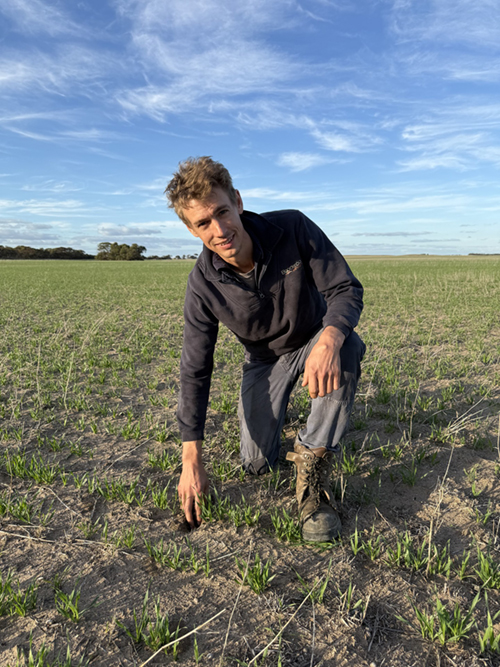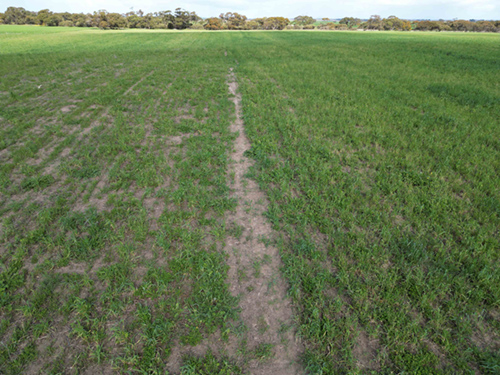Local knowledge, lasting impact: Soil amelioration delivers
At a glance
|
In SA’s upper southeast sandy country, persistent water repellence issues and poor crop establishment have limited productivity. However, targeted soil amelioration at Booderoo – a mixed cropping and grazing enterprise near Coomandook – is helping to turn things around.
Over the past three years, Booderoo has been part of a Meat & Livestock Australia (MLA) project aimed at improving productivity on water-repellent sands. The project – delivered through the Coorong Tatiara local action plan – has tested practical, scalable strategies to lift production on challenging soils.

Booderoo manager Arran Loechel assessing crop recovery in 2025. Photo: Melissa Fraser
A paddock with potential
The paddock under trial at Booderoo was no stranger to variability. Persistent challenges included patchy pasture establishment, low biomass growth and a dwindling lucerne stand. Soil testing confirmed severe water repellence in the sandy rises and subsurface compaction across much of the paddock.
In 2022, a suite of amelioration treatments was implemented, ranging from deep ripping with a Bednar terraland to complete soil inversion using a Plozza plow.
Potassium fertiliser was applied to the whole paddock to address deficiency. A local source of aged manure and bedding from nearby pig sheds was also tested. The focus was on using practical approaches that could be adopted at scale.
“We’ve got a lot of unproductive sandy patches that always bring the paddock average down. I was keen to see if we could improve the sand – and if it could be done at scale. It looks like it can, which is good.” − Booderoo manager Allan Loechel
What did it show?
Visual differences were evident each year, with faster and more uniform establishment on ripped and inversion treatments, as well as faster recovery after grazing.
Pasture biomass assessments from the first season confirmed the visual difference. Average dry matter on deep tilled treatments increased by 32% above the non-tilled controls at 5.3 tonnes per hectare. The addition of aged pig manure gave an extra 82%.
The recovery and productivity boost continued into 2023 and 2024. Dry matter assessments and satellite imagery confirmed greater groundcover and pasture vigour on ameliorated soils.
Of the treatments trialled, it was the combination of soil inversion using a Plozza plow and pig manure that generated the best gains, leading to more than 70% yield increase over the monitored three years.
“The biggest change has been soil cover and germination. With the Plozza plow, you can almost plant it dry now, whereas before you never could. It’s opened up the sowing window and given us a more even germination across the whole paddock,” said Arran.
Locally led, locally relevant
What makes the Booderoo trial valuable is the use of local soils, local constraints, and local knowledge. The practical focus of the project meant producers could see side-by-side comparisons of treatments in their own farming system, making the results more relatable and the adoption pathway clearer.
A highlight of the site’s extension work has been in-paddock discussion sessions and skills-based workshops. Throughout 2022 and 2023, more than 60 producers have visited the site, hearing firsthand from project leader Dr Melissa Fraser about what worked, what didn’t, and how decisions were made on-farm.
Lessons learned
The trial confirmed what many growers in the region have long suspected - that water repellence and subsoil constraints are costing both crop and pasture production and that real gains are to be made through amelioration.
It also highlighted that success depends on matching the solution to the constraint. Where deep ripping alone improved compaction, it was inversion that addressed water repellence more fully.
It identified it is profitable to ameliorate sandy soils used for grazing. Economic assessment showed that amelioration treatments costing up to $300 per hectare can be recovered in 1.5 years at a gross margin of $45 per dry sheep equivalent (DSE). If pasture utilisation was increased from 40% to 60%, the cost could be recovered in the first year.
“It’s not worth shortcutting. Just spend the extra time and money and get it right the first time. Cover it, stabilise it, and protect against wind. For us, that’s meant using manure, rolling, and broadcasting seed straight after tillage,” Arran said.
The road ahead
Encouraged by the results, Booderoo have continued to roll out amelioration across other parts of the property, seeing soil inversion as a crucial first step.
“We’ll keep doing more with the Plozza plow and then maybe come back later with the Bednar on some strips if we need to.
“On most of our hills, inversion has fixed 70−80% of the problem. After that, it’s just the really poor sand that needs another pass.
“The aged pig manure is something we’ll keep using. It stabilises the surface and helps with erosion risk. Broadcasting seed and rolling straight after tillage is also critical in our conditions,” Arran said.
Arran’s advice for others is to pick your season, “If it’s too dry, the gear won’t dig in and you won’t get the cover. Bring up wet sand and then move fast, get it sown and covered before the wind hits.”
Arran’s advice for others is to pick your season, “If it’s too dry, the gear won’t dig in and you won’t get the cover. Bring up wet sand and then move fast, get it sown and covered before the wind hits.”

Aerial image of the site in 2023, showing better pasture growth where the topsoil had been inverted in 2022 (right), compared to the no-tillage control (left). Photo: Mel Fraser
Matching tillage to target constraints (Pop out):
|



